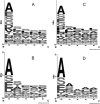Comparative large scale characterization of plant versus mammal proteins reveals similar and idiosyncratic N-α-acetylation features
- PMID: 22223895
- PMCID: PMC3433923
- DOI: 10.1074/mcp.M111.015131
Comparative large scale characterization of plant versus mammal proteins reveals similar and idiosyncratic N-α-acetylation features
Abstract
N-terminal modifications play a major role in the fate of proteins in terms of activity, stability, or subcellular compartmentalization. Such modifications remain poorly described and badly characterized in proteomic studies, and only a few comparison studies among organisms have been made available so far. Recent advances in the field now allow the enrichment and selection of N-terminal peptides in the course of proteome-wide mass spectrometry analyses. These targeted approaches unravel as a result the extent and nature of the protein N-terminal modifications. Here, we aimed at studying such modifications in the model plant Arabidopsis thaliana to compare these results with those obtained from a human sample analyzed in parallel. We applied large scale analysis to compile robust conclusions on both data sets. Our data show strong convergence of the characterized modifications especially for protein N-terminal methionine excision, co-translational N-α-acetylation, or N-myristoylation between animal and plant kingdoms. Because of the convergence of both the substrates and the N-α-acetylation machinery, it was possible to identify the N-acetyltransferases involved in such modifications for a small number of model plants. Finally, a high proportion of nuclear-encoded chloroplast proteins feature post-translational N-α-acetylation of the mature protein after removal of the transit peptide. Unlike animals, plants feature in a dedicated pathway for post-translational acetylation of organelle-targeted proteins. The corresponding machinery is yet to be discovered.
Figures




References
-
- Persson B., Flinta C., von Heijne G., Jörnvall H. (1985) Structures of N-terminally acetylated proteins. Eur. J. Biochem. 152, 523–527 - PubMed
-
- Driessen H. P., de Jong W. W., Tesser G. I., Bloemendal H. (1985) The mechanism of N-terminal acetylation of proteins. CRC Crit. Rev. Biochem. 18, 281–325 - PubMed
-
- Tsunasawa S., Sakiyama F. (1984) Amino-terminal acetylation of proteins: An overview. Methods Enzymol. 106, 165–170 - PubMed
-
- Meinnel T., Peynot P., Giglione C. (2005) Processed N-termini of mature proteins in higher eukaryotes and their major contribution to dynamic proteomics. Biochimie 87, 701–712 - PubMed
-
- Meinnel T., Giglione C. (2008) Tools for analyzing and predicting N-terminal protein modifications. Proteomics 8, 626–649 - PubMed
Publication types
MeSH terms
Substances
LinkOut - more resources
Full Text Sources
Molecular Biology Databases

